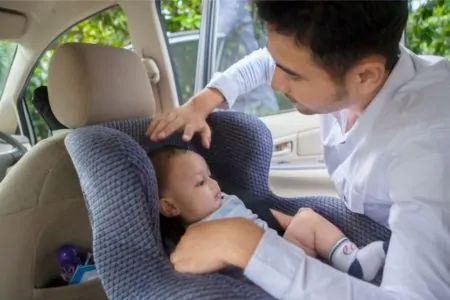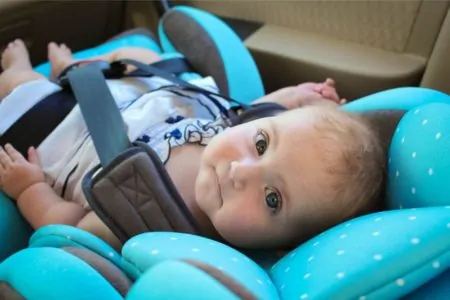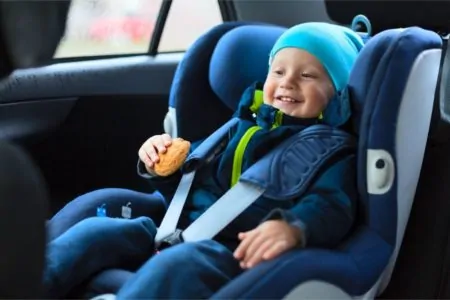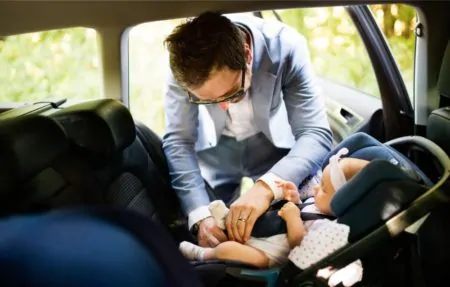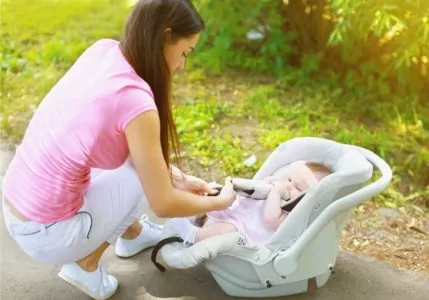We will break down the safety facts, the physics of a crash, and expert guidelines on when to finally make the switch.
We all want our kids to be safe in the car. Here is how to make the right call.
Key Takeaways
- Keep children rear-facing until they reach the absolute maximum weight or height limit allowed by their specific car seat manufacturer.
- Rear-facing seats provide superior protection for a developing child’s head, neck, and spinal cord during crash forces.
- Children are naturally flexible and are typically comfortable with their legs bent or crossed in a rear-facing position.
- If your baby outgrows their infant carrier before age 2, switch to a convertible car seat with higher rear-facing limits rather than turning them forward.
When Is the Right Time to Transition?
Parents know a car seat is non-negotiable. However, the laws and safety standards surrounding placement can be daunting. The most common confusion stems from the transition timeline. When can you actually flip that seat around?
You might have heard the old advice that children can ride facing forward after their first birthday or once they weigh 20 pounds. That standard is outdated and unsafe. Currently, the American Academy of Pediatrics (AAP) and the National Highway Traffic Safety Administration (NHTSA) recommend keeping children rear-facing for as long as possible. This means waiting until they reach the top height or weight limit allowed by your car seat’s manufacturer (1).
For most modern seats, this allows children to stay rear-facing past the age of 2, and often up to age 4. Many states have even updated their laws to mandate rear-facing until at least age 2.
Why Is Rear-Facing Better?
Manufacturers design seats to handle higher capacities because the physics of a crash dictates that rear-facing is safer. Most convertible car seats now accommodate rear-facing children up to 40 or even 50 pounds.
But why is the orientation so critical?
In a rear-facing position, the hard shell of the car seat cradles and supports the child’s head, neck, and spine. During a collision, the seat absorbs the impact forces. The child moves with the seat, which keeps their vulnerable spinal cord aligned.
When a child faces forward, they are restrained only by the harness straps over their shoulders and hips.
In a frontal crash (the most common type), a forward-facing child’s head is thrown forward with tremendous force. This is dangerous because a toddler’s head is disproportionately large and heavy. In fact, the head makes up approximately 25% of a young child’s total body weight.
Additionally, a child’s vertebrae do not fully fuse until they are between 3 and 6 years old. This means their spinal column cannot withstand the same tension as an adult’s. If the head jerks forward violently, it can stretch the spinal cord, leading to severe injury or even internal decapitation (2).
Even if you are eager to hit the next milestone, delay this transition. Check your manual for the exact limits. If your child fits the height and weight requirements for rear-facing, keep them there.
Won’t Their Legs Be Uncomfortable?
Parents often worry when they see their child’s legs touching the back seat. It looks cramped to adult eyes. However, children are much more flexible than adults. Their joints are loose, and this “cramped” position is actually safe and comfortable for them.
If your child seems restless, it is likely just a need to move rather than leg pain.
What If They Reach the Car Seat Limit Before 2 Years?
This is a common scenario with infant car seats (the bucket style with a handle). Babies often hit the height limit of these seats well before their second birthday.
This does not mean you should turn them forward. Instead, you need to buy a convertible car seat. These seats are larger, stay in the car, and have much higher rear-facing limits.
Regarding height, the general rule of thumb is to ensure there is at least one inch of space between the top of your child’s head and the top of the car seat shell. This buffer zone ensures your child’s head stays protected within the shell during a crash.
If you switched your child to forward-facing early because they outgrew the infant carrier, consider switching them back with a convertible seat. I did this with my own toddler after learning the safety stats. It gave me immense peace of mind knowing my child was significantly safer (3).
Aren’t Rear Car Accidents Just as Bad?
Rear-end collisions account for roughly 25% of all accidents. While they are frequent, they typically result in less severe injuries than frontal or side-impact crashes (4).
In a rear-end collision, two vehicles are usually moving in the same direction, which reduces the severity of the force. Furthermore, even in a rear-impact crash, a rear-facing seat performs well. The seat will rotate toward the point of impact, and the child is still cocooned within the protective shell.
What If Your Child Doesn’t Like Rear-Facing?
A screaming toddler is a major distraction for any driver. When a child is crying and wailing, your focus pulls away from the road, which increases accident risks.
However, resistance to the car seat is usually just a behavioral phase rather than a problem with the seat direction. Turning them forward rarely solves the tantrum issue permanently.
To help them cope, use a shatter-proof car mirror attached to the headrest. This allows you to see each other in the rearview mirror. Just ensure it is securely strapped (avoid simple Velcro) so it does not become a projectile. Older toddlers can also keep themselves busy with soft toys or by looking out the rear window.
Do Rear-Facing Seats Cause Motion Sickness?
This is a common misconception. Motion sickness generally occurs when there is a disconnect between what the eyes see and what the inner ear feels. This happens most often when looking out side windows where objects blur by quickly.
Rear-facing children actually have a stable view out the back window. If your child does struggle with nausea, try placing a sunshade over the side window to block the peripheral blur. You can also adjust the recline angle if your seat manual permits it for your child’s age.
If you have a vehicle with three rows, keep children who are prone to motion sickness in the second row. This usually gives a smoother ride with fewer bumps.
Editor's Note:
Kristen Gardiner, CPSTQuick Tips for the Transition
Here are a few guidelines to remember when you are finally ready to switch your child from rear-facing to forward-facing:
- Use the tether: When you switch to a forward-facing seat with a harness, you must attach the top tether strap to the anchor point in your vehicle. This is crucial for reducing head excursion in a crash.
- Max out the limits: Keep your child in the forward-facing harness until they reach the maximum height or weight allowed for that mode. Do not rush to a booster.
- Booster readiness: Once the harness is outgrown, switch to a booster seat. Children typically need a booster until they are 4 feet 9 inches tall (usually between ages 10 and 12).
- Seat belt fit: The goal of a booster is to position the seat belt correctly. The lap belt should lie flat across the upper thighs (not the stomach), and the shoulder belt should cross the chest and shoulder (not the neck) (5).
